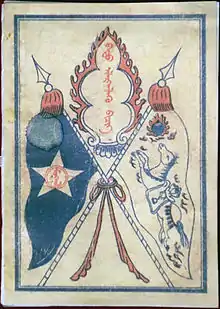Ga is a letter of related and vertically oriented alphabets used to write Mongolic and Tungusic languages.[1]: 549–551
Mongolian language
Look up ᠭ in Wiktionary, the free dictionary.
| Ga | ||||||||||||||||||||||
|---|---|---|---|---|---|---|---|---|---|---|---|---|---|---|---|---|---|---|---|---|---|---|
.svg.png.webp) | ||||||||||||||||||||||
| The Mongolian script | ||||||||||||||||||||||
| Mongolian vowels | ||||||||||||||||||||||
| ||||||||||||||||||||||
| Mongolian consonants | ||||||||||||||||||||||
| ||||||||||||||||||||||
| Foreign consonants | ||||||||||||||||||||||
| Letter[2]: 14–15, 17, 21–22, 24–25 [3]: 546 [4]: 212–213 | ||
|---|---|---|
| γ (ɣ) | g | Transliteration[note 1] |
| ᠭ | Initial | |
| ᠭ᠋⟨?⟩ ⟨ |
ᠭ᠍⟨?⟩ ⟨ |
Medial (syllable-initial) |
| ᠭ⟨?⟩ ⟨ |
Medial (syllable-final) | |
| ᠭ[lower-alpha 1] | ᠭ᠋⟨?⟩ ⟨ |
Final |
| C-V syllables[2]: 15 [10]: 21 | ||||||
|---|---|---|---|---|---|---|
| γ‑a | γa | ge | gi | γo, γu | gö, gü | Transliteration |
| — | ᠭᠠ | ᠭᠡ[lower-alpha 2] | ᠭᠢ[lower-alpha 3] | ᠭᠣ᠋ | ᠭᠥ⟨?⟩ ⟨w/o tail⟩[lower-alpha 4] | Alone |
| ᠭᠥ᠋⟨?⟩ ⟨w/ tail⟩ | ||||||
| — | ᠭᠠ | ᠭᠡ | ᠭᠢ | ᠭᠣ | ᠭᠥ | Initial |
| — | ᠭᠠ | ᠭᠡ | ᠭᠢ | ᠭᠣ | ᠭᠥ | Medial |
| ᠭᠠ⟨?⟩ ⟨ |
— | ᠭᠡ | ᠭᠢ⟨?⟩ ⟨ᠬᠢ⟩ | ᠭᠣ | ᠭᠥ | Final |
γ/g
- Produced with G using the Windows Mongolian keyboard layout.[12]
- In the Mongolian Unicode block, γ/g comes after q/k and before m.
γ
- Transcribes Chakhar /ɣ/;[13] Khalkha /ɢ/, and /∅/.[14]: 40–42 Transliterated into Cyrillic with the letter г.[10][5]
- Dotted before a vowel (attached or separated); undotted before a consonant (syllable-final) or a whitespace.[2]: 21 [3]: 546 [15]: 5 [13]
- May turn silent between two adjacent vowels, and merge these into a long vowel or diphthong.[2]: 36–37 [8]: 7 Qaγan (ᠬᠠᠭᠠᠨ) 'Khagan' for instance, is read as Qaan unless reading classical literary Mongolian. Some exceptions like tsa-g-aan 'white' exist.
- Derived from Old Uyghur merged gimel and heth (𐽲).[3]: 539–540, 545–546 [16]: 111, 113–115 [8]: 35
g
- Transcribes Chakhar /g/;[13][17] Khalkha /g/. Transliterated into Cyrillic with the letter г.[10][5]
- Syllable-initially indistinguishable from k.[2]: 15, 24 [11]: 9 When it must be distinguished from k medially, it can be written twice (as in ᠥᠭᠭᠦᠭᠰᠡᠨ öggügsen 'given', compared with ᠦᠬᠦᠭᠰᠡᠨ ükügsen 'dead').[11]: 59 [18]
- The final form is also found written like the bow-shaped Manchu final ᡴ᠋ k.[8]: 39

- May turn silent between two adjacent vowels, and merge these into a long vowel or diphthong.[2]: 36–37 [8]: 7 Deger for instance, is read as deer. Some exceptions like ügüi 'no' exist.
- Derived from Old Uyghur kaph 𐽷).[3]: 539–540, 545–546 [16]: 111, 113, 115 [8]: 35
Clear Script
Look up ᡎ in Wiktionary, the free dictionary.
Xibe language
Look up ᡤ in Wiktionary, the free dictionary.
Manchu language
Look up ᡤ in Wiktionary, the free dictionary.
Notes
- 1 2 For the two harmonic variants of the particle ᠰᠢᠭ᠋⟨?⟩/ᠰᠢᠭ⟨?⟩ siγ/sig (шиг shig) 'similar to, similarly, like' etc., the choice between final γ or g is dependent on whether it occurs after a masculine or a feminine word, respectively.[7]: 699 [8]: 44 [9]: 201
- ↑ As in ᠬᠡ/ᠬᠡᠭᠡ/ᠬᠡᠭᠡᠨ ke/kege/kegen (хээ khee) 'pattern, piping, design, stamp'.[7]: 438, 442
- ↑ See the separated ᠬᠢ ‑ki suffix.[7]
- ↑ As in the strengthening (emphatic) ᠭᠦ⟨?⟩ kü (хүү khüü) particle,[7]: 494 [11]: 46 or ᠬᠥ⟨?⟩/ᠬᠥᠭᠡ kö/köge (хөө khöö) 'soot; obstacle, hindrance; trouble', or 'ring of mail'.[7]: 475, 478
References
- ↑ "The Unicode Standard, Version 14.0 – Core Specification Chapter 13: South and Central Asia-II, Other Modern Scripts" (PDF). www.unicode.org. Retrieved 2022-05-16.
- 1 2 3 4 5 6 Poppe, Nicholas (1974). Grammar of Written Mongolian. Otto Harrassowitz Verlag. ISBN 978-3-447-00684-2.
- 1 2 3 4 Daniels, Peter T.; Bright, William (1996). The World's Writing Systems. Oxford University Press. ISBN 978-0-19-507993-7.
- ↑ Bat-Ireedui, Jantsangiyn; Sanders, Alan J. K. (2015-08-14). Colloquial Mongolian: The Complete Course for Beginners. Routledge. ISBN 978-1-317-30598-9.
- 1 2 3 "Mongolian transliterations" (PDF). Institute of the Estonian Language. 2006-05-06.
- ↑ "Mongolian Transliteration & Transcription". collab.its.virginia.edu. Retrieved 2023-03-26.
- 1 2 3 4 5 Lessing, Ferdinand (1960). Mongolian-English Dictionary (PDF). University of California Press. Note that this dictionary uses the transliterations c, ø, x, y, z, ai, and ei; instead of č, ö, q, ü, ǰ, ayi, and eyi;: xii as well as problematically and incorrectly treats all rounded vowels (o/u/ö/ü) after the initial syllable as u or ü.[6]
- 1 2 3 4 5 6 Janhunen, Juha (2006-01-27). The Mongolic Languages. Routledge. ISBN 978-1-135-79690-7.
- ↑ Janhunen, Juha A. (2012). Mongolian. John Benjamins Publishing. ISBN 978-90-272-3820-7.
- 1 2 3 Skorodumova, L. G. (2000). Vvedenie v staropismenny mongolskiy yazyk Введение в старописьменный монгольский язык (PDF) (in Russian). Muravey-Gayd. ISBN 5-8463-0015-4.
- 1 2 3 Grønbech, Kaare; Krueger, John Richard (1993). An Introduction to Classical (literary) Mongolian: Introduction, Grammar, Reader, Glossary. Otto Harrassowitz Verlag. ISBN 978-3-447-03298-8.
- ↑ jowilco. "Windows keyboard layouts - Globalization". Microsoft Docs. Retrieved 2022-05-16.
- 1 2 3 "Mongolian Traditional Script". Chinese, Japanese, Vietnamese, and Mongolian Language Site. Retrieved 2022-05-16.
- ↑ Svantesson, Jan-Olof; Tsendina, Anna; Karlsson, Anastasia; Franzen, Vivan (2005-02-10). The Phonology of Mongolian. OUP Oxford. ISBN 978-0-19-151461-6.
- ↑ "A Study of Traditional Mongolian Script Encodings and Rendering: Use of Unicode in OpenType fonts" (PDF). COLIPS – Chinese and Oriental Languages Information Processing Society. Retrieved 2022-05-16.
- 1 2 Clauson, Gerard (2005-11-04). Studies in Turkic and Mongolic Linguistics. Routledge. ISBN 978-1-134-43012-3.
- ↑ "Writing – Study Mongolian". Study Mongolian. August 2013. Retrieved 2022-05-16.
- ↑ "Mongolian State Dictionary". Mongol toli (in Mongolian). Retrieved 2022-05-16.
This article is issued from Wikipedia. The text is licensed under Creative Commons - Attribution - Sharealike. Additional terms may apply for the media files.